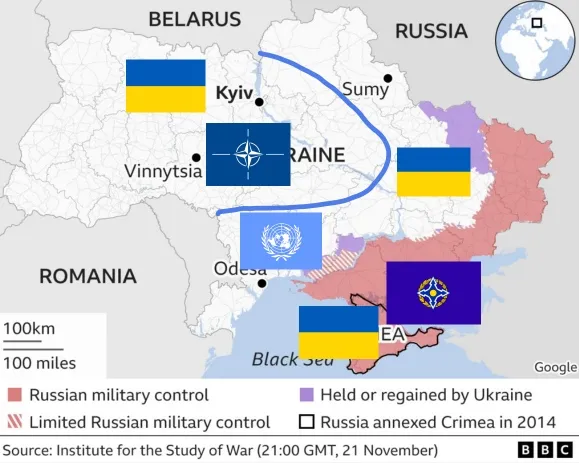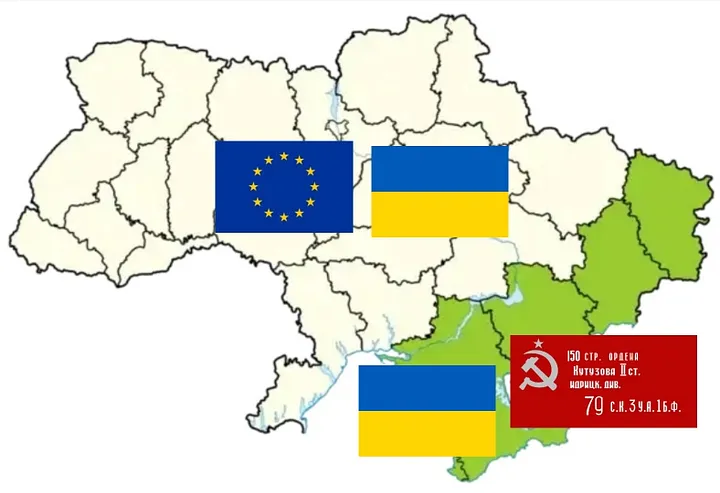In the Zelensky Peace Formula, security guarantees for Ukraine mostly come from the Kyiv Security Compact (point 9). This framework, designed by former NATO Secretary General Anders Fogh Rasmussen, legally guarantees military supplies from NATO countries, without waiting for full NATO membership.
Secondary security guarantees come from Russia itself, through a document signed by ‘the parties’ (point 10), i.e. a peace treaty.

Although Rasmussen suggests that the Kyiv Security Compact “could be embedded in an eventual peace process”, he doesn’t specify how this embedding should be done. In this article, I outline a possible solution, building upon Rasmussen’s plans.
Three Security Zones inside a united Ukraine
My recommendation is to permanently sub-divide Ukrainian territory into three concentric security zones:

- NATO zone: Ukraine mainland, where the Kyiv Security Compact is applied, and where Leopard tanks and F-16 fighter jets are stationed. That’s the new military realities that Russia needs to accept.

- CSTO zone: territories currently under Russian control. They withdraw their troops, and replace them with a CSTO peacekeeping force, without Russian participation. That’s the new territorial realities that Ukraine needs to accept.

- UN-neutral zone: Ukraine demilitarizes all regions bordering territories with Russian troops: Chernihiv, Sumy, Kharkiv, Dnipro, Mykolaiv, Odessa, in exchange of Russian withdrawal from the CSTO zone. In this buffer zone, security is guaranteed by a UN peacekeeping force, which can include Russia’s biggest arms buyers, such as India, China, Algeria or Egypt, and moderate NATO countries, such as Turkey or Hungary.

Three differences with previous UN peacekeeping plans
Rasmussen already developed a UN peacekeeping mission proposal, back in 2018:

At that time, the Rasmussen plan failed to gather consensus. My proposal has 3 differences with Rasmussen, raising chances of success:
First difference: International peacekeepers should come after political settlement, not before. The Rasmussen plan was based upon the Minsk agreement, in which the final settlement depended on “local elections”. These elections never happened, too much was at stake.
In my proposal, local elections are irrelevant. They can’t change the final status, constitutionally enshrined, based on two recognitions:
- the Russian Federation recognizes the 1991 borders and European integration aspirations of Ukraine, by following legal procedures defined in Chapter 9 of the Constitution of the Russian Federation.
- In exchange, Ukraine recognizes the existing reality of Eurasian integration of Crimea, Kherson, Zaporozhye, Donetsk and Lugansk regions into the Eurasian Economic Union, by following legal procedures defined in Chapter XIII of the Constitution of Ukraine.

Second difference: A large buffer zone within Ukraine-controlled territory is created. This additional zone didn’t exist in the Rasmussen peacekeeping plan, nor in the Kortunov plan from the Russian International Affairs Council. Like them, I also propose a phased deployment from the line of contact towards the internationally recognized border of Russia.
However, I also add a second team of UN peacekeepers, who simultaneously move in the opposite direction, inside Ukraine-controlled territory, to create a demilitarized buffer zone. For example, Turkish and Kazakh troops can deploy according to this plan:

Turkey and Kazakhstan are already consolidating their “enhanced strategic partnership”, despite belonging to rival NATO and CSTO alliances.

Third difference: this UN peacekeeping mission is expected to be permanent.
Objectives on both sides get accomplished: Ukraine obtains the withdrawal of Russian troops, and Russia obtains the regional demilitarization of Ukraine. This new peacekeeping formula creates automatic snapback provisions for each side: Ukraine can re-militarize the UN-neutral zone if Russia re-deploys troops in South-East Ukraine, and vice-versa.
The Camp David precedent in Egypt
Permanent demilitarization in exchange of territory has a modern precedent: in 1978 at Camp David, Egypt agreed to demilitarize Sinai, and instead to allow permanent US troops in the Multinational Force & Observers, as a security guarantee for Israel.


The Camp David agreement permanently established four security zones: three in the Sinai in Egypt and one in Israel along the international border. Military forces and equipment are limited within each zone.

Critics in Egypt and across the Arab world argued that Camp David was a capitulation, a humiliating peace treaty that resulted in a loss of sovereignty for Egypt. Egyptian President Sadat was even assassinated because of Camp David.
However, if President Sadat had refused to sign at Camp David, it’s likely that Egypt would have followed the same course as Syria, where no peace agreement with Israel was reached. In 1981, Israel annexed the Golan Heights, without offering any security guarantees to Syria. Nowadays, Israel still airstrikes Syria, 56 years after the war that led Israel to capture Sinai from Egypt, and Golan from Syria.

Likewise, in Ukraine and across the Western world, similar feelings of frustration will be expected, since mutual security guarantees won’t bring the most glorious endgame to Ukraine.
For example, former Ukrainian President Petro Poroshenko proposed an alternative “peace formula” without any peace treaty, or any potential compromise with Russia, contrary to the Zelensky formula. Poroshenko formula can perpetuate instability in Ukraine for decades, as in the not-so-frozen conflict between Syria and Israel.
Mutual security guarantees in the Rules-Based International Order
In conclusion, mutual security guarantees between Ukraine and Russia can be modeled after the Camp David Accords of 1978 between Egypt and Israel. This landmark peace agreement shaped the Rules-Based International Order that Ukraine and their Euro-Atlantic partners vowed to respect and defend. Therefore, the West can logically accept the Camp David model, as a Rules-Based solution to the confrontation happening in Ukraine.
Join our email list and get notified about new content
Be the first to receive our latest content with the ability to opt-out at anytime.



